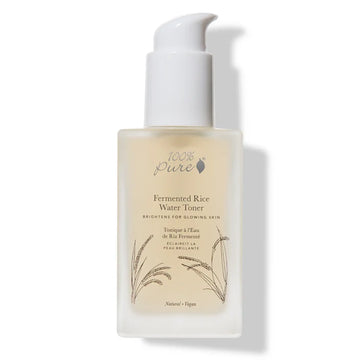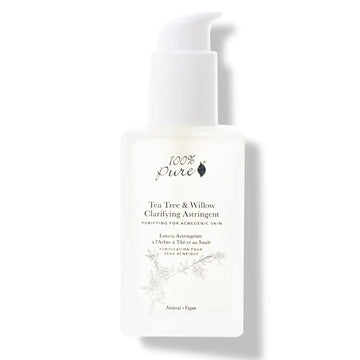Unlocking the secrets of astringents – including who should use them
Written by: 100% PURE ®
While there’s no lack of disagreement in skin care, there’s one thing we can all agree on: we know a lot more about clearing acne than we did twenty years ago!
As a result, plenty of products have evolved from what their original formulas were. One of the best examples of this product evolution is astringents. The word “astringent” sounds abrasive, stripping, and downright tough on skin. But as you’re about to see, astringents have become drastically different from what they used to be. They may be far more versatile than you think!
When it comes to astringents, there’s one particular question that leaves many individuals a bit confused: what’s the difference between astringents and toners? In simple terms, astringents are actually a type of toners. So what are toners?
WHAT IS A TONER?
While toners may appear as nothing more than a clear, slightly viscous liquid, they can actually make a huge difference in your natural skin care routine. Toners are water-based products that are meant to be applied after the cleansing step.
Even if a cleanser is made with the most gentle ingredients, like our Lavender Oat Milk Soothing Cleanser, the fact of the matter is that when you remove impurities and makeup from your skin, you’re likely going to lose some important natural oils in the process. This results not only in a sudden case of dryness, but disruption to your skin’s natural pH balance.
When we apply a natural toner, we’re promoting a rebalancing of these levels in your skin, making your skin more prepared for the rest of your skin care. Toners are also great for helping remove any debris left on your skin that your cleanser might have missed. Our Fermented Rice Water Toner and Sea Culture Hydrating Toner are two examples of replenishing toner formulas.
WHAT IS AN ASTRINGENT?
As for astringents, these too would be used directly after cleansing. The main difference, however, is that astringents focus especially on the role of removing debris from your skin; even more so than toners.
In fact, the main function of astringents is to remove excess oil from your skin. This can help large pores shrink up to purge any excess sebum, while preventing more bacteria from entering.
Astringents are also great for healing blemishes and reducing scarring. Thanks to their antifungal properties, they can also help relieve irritated skin and prevent fungal infections.
When understanding the differences between toners and astringents, it’s good to note that while toners can be hydrating, most astringents tend to have a more drying effect on the skin. For this reason, it’s as crucial as ever to follow up with a moisturizer.
And while it’s always important to stick with ingredients that are gentle on skin, it should be noted that astringents especially have a history of stripping formulations. But not all astringents are like this: take our Tea Tree & Willow Astringent, which we’ll dive into next.

So who exactly are astringents made for? Who can benefit most from using an astringent in their skin care routine?
When astringents were first brought onto the skin care market decades ago, they were largely marketed as a product for those with acne-prone or oily skin.
Traditionally formulated with isopropyl alcohol, the original astringents were, quite literally, meant to suck all of the moisture out of your skin. This would effectively dry out pimples and leave skin ‘squeaky-clean’.
At this time, the philosophy behind clearing acne was to annihilate all oil, because oil equals acne, which equals bad. Nowadays, we know a bit more about skin care. It’s more widely understood that completely stripping your skin can not only continue the cycle of acne, but lead to more issues like irritation.
As a result, there are far more astringents available that are both effective for clearing skin and gentle on the skin barrier.
Our Tea Tree & Willow Clarifying Astringent is non-stripping and hydrating, but still works against acne and excess oil. Unlike alcohol-based astringents, this one works to bring oil back to a normal level rather than eradicate it completely.
Thanks to modern formulations like this one, astringents are more useful than ever for oily and acne-prone skin!
Astringents make a great skin care step for those with oily and acne-prone skin types, but who wouldn’t benefit from using them?
Trick question! Astringents are actually suitable for anyone, as long as you’re using the right formulations.
Astringents have gained a bad reputation for some of the ingredients they traditionally use, but when you use an astringent with gentle, skin-restoring ingredients, they’re suitable for all skin types.
For instance, those with dry skin may undergo a lot of inflammation and irritation, and would benefit from a soothing astringent. The Éminence Organic Soothing Chamomile Tonique uses soothing herbs to help clarify skin while restoring balance.
Those with combination and even normal skin types can go through periods of excess oil and breakouts, particularly in the T-zone. If occasional oiliness ever happens to you, a mild astringent should make a worthy addition to your skin care arsenal.
Try the Marie Veronique Balancing Hypo Tonic, which clears up the skin and fights blemishes with apple cider vinegar and licorice root extract. Green tea and beta-glucan help bring down redness and irritation.
So which ingredients should be avoided in an astringent?
No matter your skin type, always steer clear of formulas containing:
-
Synthetic fragrance
-
Parabens
-
Artificial colors & dyes
-
Alcohol
-
Sodium lauryl sulfate (SLS)
Abrasive, stripping astringents may still be out there, and they’ll always pose a potential risk to your skin. But with no shortage of gentle alternatives, they can be easily avoided for your best skin yet!
We carefully hand-select products based on strict purity standards, and only recommend products we feel meet this criteria. 100% PURE™ may earn a small commission for products purchased through affiliate links.
The information in this article is for educational use, and not intended to substitute professional medical advice, diagnosis, or treatment and should not be used as such.
















